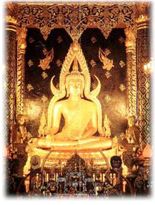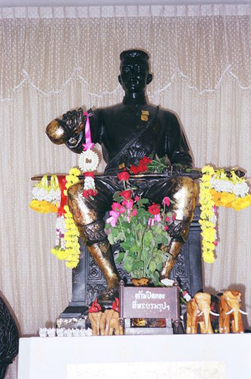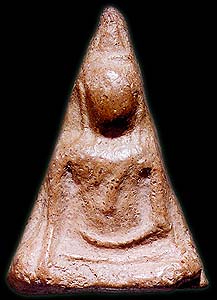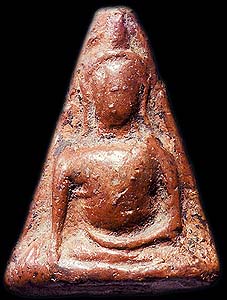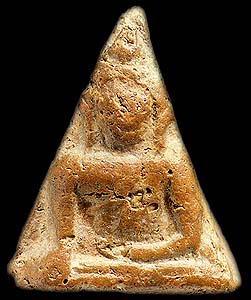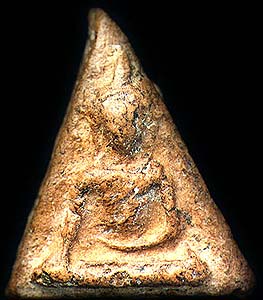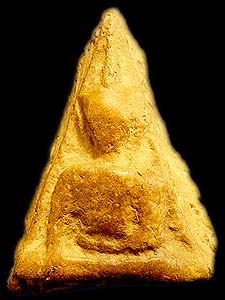It is believed that the lands of Mae Hong Son had already been settled before the arrival of Lord Kaeo of Ma (Chao Kaeo Mueang Ma) and his consequent resettlement in the area. However, there is no evidence as to what time or period they arrived, nor of their migrations thereafter. These former inhabitants have left evidence of their activity in the area and are believed to have been Lua, or Lawa, tribespeoples. Evidence to date includes gravesites and discarded housing structures such as those found in the vicinity of the Mae Hong Son Municipal Hall, nowadays the Morning Markets and Dharma School, by the Chong Klang and Chong Kham monasterial compound. These first settlers were likely depopulated by either malaria or war, with survivors then dispersing out to safer areas.
The old, pre-Rattanakosin lands of Mae Hong Son was merely a collective of forest settlements without a central government, with Shan peoples who had crossed into the area from beyond the frontier with the Union of Burma in search of a means to find food, working in agroforestry and joint plantations as the seasons permitted. During this period the area was significant only as a passage for Burman troops marching on the capital at Ayutthaya or to the various Siamese capitals of Northern Thailand.
Mae Hong Son historical records state that in the year 1831, which corresponds to the reign of King Nangklao (Rama III) of the Rattanakosin Period, in the mueang of Phing Nakhon known today as Chiang Mai, in the lands of the Kingdom of Lannathai, was Phraya Chiang Mai Mahawong, who was later to ascend to the rank of Phra Chao Mahottraprathet Racha Thibodi, who knew that to the west of Chiang Mai, which meant the lands of today’s Mae Hong Son, was a geography of tall mountains and dense forests inhabited by a myriad of forest creatures of which wild elephants in particular were in great abundance, and thus ordered Lord Kaeo, who was a relative of his and a local military chief and governor, to herd these elephants out into the custody of mahouts, to survey the feasibility of this task on such western frontierlands and to be of further service in the capturing of the elephants so that they might be trained for labour thereafter.
Lord Kaeo assembled his troops, lure-elephants and mahouts and set out from Chiang Mai, bound for a shortcut which entered northeast along a brook leading them to complex mountain ranges. After a short trip they arrived in the hamlet of Wiang Pai, or Amphoe Pai as it is known today. Here, Kaeo and his commission stopped a while before resuming

their expedition. They then headed south to find a shortcut along the Pai River, so that they might ascend into the mountains once more.
After travelling for a longer period this time, they then headed back towards the Pai River. On arrival, they found a tiny community living in the area, either Shan or otherwise Tai, with hamlets along the Pai River amid vast areas of thick, virgin forest. Lord Kaeo deemed this location most suitable to build a village, with ample land to extend the scope of the village in the future and abundant saltlicks nearby the houses for boars; all one required in maintaining a successful village.
Lord Kaeo then rehabilitated the various scattered settlements into a single village and had them elect a leader referred to as a Heng; Phakamong, a Shan, was thus elected as the village heng. (The village elder, or kamnan, ruled over the village, and it was then named Ban Pong Mu, or Village of the Boar Saltlick. It later became Ban Pang Mu, Tambon Pang Mu, Amphoe Pang Mu, Changwat Mae Hong Son. Lord Kaeo, together with Phakamong, then travelled further south with a number of their elephants in tow into the realm of what is today’s Mae Hong Son. Finding it a suitable location with a stream flowing by from east to west into the Pai River and a second brook running further north, he decided it would be most fitting to establish his elephant training camp there along with a residential base for personnel. Subsequently, he constructed an elephant pen on the banks of the stream and the area became another village for the Shan settlers, although with a smaller population than that of Ban Pong Mu. After Lord Kaeo had captured the satisfactory quota of elephants and had trained them as instructed, he decided to head back, and so elected the son-in-law of Phakamong, Saenkom, as the Kang or village chief to oversee the village and it was then that the village was named Ban Mae Rong Son, or Village of the Elephant Training Camp Bayou; later, the name Mae Rong Son was corrupted to Mae Hong Son, as pronounced in the brogue of the Lannanese (initial r’s are often pronounced as h’s), and the aforementioned second brook that ran north was named Lamnam Pu on finding water there splashing up from the earth (lamnam refers to any body of flowing water; pu is the sound produced when throwing a stone or brick into the mud or against a soft substance).
The village of Mae Rong Son flourished and prospered and Shan began migrating there in increased numbers. Aside from this wave, in around the year 1856 there arose much political unrest on the western banks of the Salween River which furthered the influx of peace-loving Shan, and again in 1876 when war broke out between the blood-princes of the principalities of Nai and Mok Mai respectively. Prince Kolan of Mok Mai, unable to sustain the battle, moved his family to live with Saenkom in Mae Rong Son along with his wife Nang Khiao, their son Khun Long, their grandson Khun Ae and their granddaughters, Chao Nang Nu and Chao Nang Mia.
By 1874, with the village of Mae Rong Son having become a huge community with a constant influx of migrants and so it was agreed that it should change its status to that of a fully fledged mueang. Lord Inthawichayanon, Lord of Chiengmai, thus elected a Shan named Chankale to be its first partasakti (somewhere between a count, in non-prerogative terms, and a governor) and bestowed on him the title of Phaya Singhanat Racha, or Sacred Voice of the King of the Singh, who would govern the mueang of Mae Hong Son from 1874, corresponding to the Rattanakosin Period of Rama V.
Later, in 1884, after caring for the mueang of Mae Hong Son for a decade, Phaya Singhanat Racha died. The next ruler was Chao Nang Mia, who ruled for seven years, bringing the realm to further great prosperity before passing away in 1891.
The next Lord of Mae Hong Son was Tho, referred to as Pu Khun Tho or Old Man Tho the Mandarin, who was made partasakti with the title Phaya Phithak Sayam Khet, or Lord Protector of the Fertile Soils of Siam. He governed the mueang of Mae Hong Son between 1891 to 1905 before his own passing that year.
The next figure to rule as Lord of Mae Hong Son was Khun Lu, the son of Pu Khun Tho, who reigned in his place as partasakti with the title Phaya Phisan Hong Son Buri, or Lord of the Metropolis of Hong Son Most Vast. He governed over Mae Hong Son between the years 1905 to 1941. To follow was a period of change in government administration and there would be no more such ranks and titles.
In 1890, during the reign of Rama V of Bangkok, Phraya Si Sahathep, Plat Thun Chalong of the Ministry of the Interior, completed an inspection tour of the cities in the Northwestern Mandala (see also Mandala (Southeast Asian history) and Mandala for perspective) and consulted with High Commmisioner Phraya Ritsaratchakit, who oversaw the Northwestern Mandala, to organise a new order of governance, namely, he would incorporate the partially independent city-states of Mae Hong Son, Khun Yuam, Yuam (Mae Sariang) and Pai into a single unit of government to be called the Boriwen Chiang Mai Tawantok, or Shire of Western Chiang Mai, and placed the government of the shire (which was now comparable to that of a single mueang) at Khun Yuem by appointing Nai Mot as shire reeve (as stated by the Minister for the Interior on July 11, 1901).
In 1903, the seat of government was moved from Khun Yuam to Yuam and the administrative division was renamed from Western Chiang Mai to Northern Phayap. In 1910, a royal decree saw the merging of Mae Hong Son, Yuam and Pai into a fourfold realm alongside the Mandala of Phayap, and moved the administrative capital to Mae Hong Son with Phraya Sonsurarat (Plueng) as the first Governor of Mae Hong Son Province. In 1933, governance as a territory was ceased and then reinstated as a constitutional administrative government as per the Constitution of the Kingdom of Thailand as remains in place today.






















































